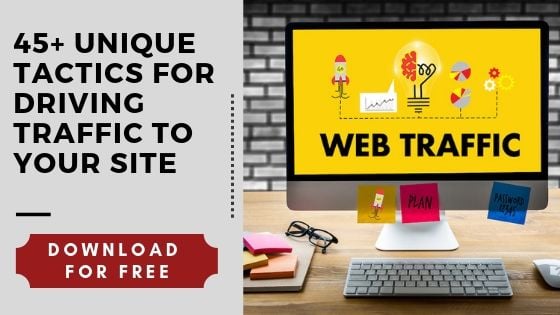This post has been updated for 2023
So you want to learn how to start a blog and make some money on the side. You see all these successful sites around you, and think, is this even possible? How can you make money from home? There are so many others out there blogging and they’re doing just fine right – why not give it a shot?
The short answer is yes, it’s possible! (But you’re going to have to put some work into it.)
In this post we will be teaching you how to start a blog in 2023 and make money from home while doing it. A word of caution before jumping in: There will be a lot covered here. At first it might look overwhelming but trust me it’s not. Don’t try to eat the elephant all in one bite. Take one or two steps at a time and act upon them, piece by piece.
But most importantly, have fun. This might sound “cheesy” but in addition to being a source of side income, or a way to work and make money from home, blogging should also be about something you are passionate about. If it’s fun and interesting for you to create, it will also be interesting and engaging for your audience.
Now, with that out of the way, let’s begin.
Table of Contents
Why Should You Start a Blog?
Benefits of Blogging
For Brand Building
Ever wondered why so many bloggers are considered industry experts or influencers? Blogging is an excellent way to share your thoughts and become an authority in your respective niche. The more your audience considers you to be a trusted (or entertaining) source of information, the more they will come back to read and share your content with their friends and followers.
For Your Audience
Why do so many people decide to spend time to read someone’s ideas on a subject? Why are so many people jumping from one blog to the next to find an answer to an issue they might have?
People today crave high quality content, long gone are the days of click-bait. This is your chance to share your experience with your target audience. It’s your chance to stand out. If you offer what they are looking for, and do it better than everyone else, you won’t only be enriching your community, but you’ll also be creating an engaged audience, (and when it comes to monetizing your site, this is crucial! We’ll explain this later.)
For Your Wallet
Blogging has enormous potential to generate a strong passive income that in some instances can be enough to rival a pretty satisfactory monthly paycheck. Let’s quickly look at an example from Neil Patel.

Neil Patel is a pretty respectable marketer and content creator in the marketing industry, (and also one of the most successful.) In one of his posts he revealed how much his blog generates in a year…the amount was $3.8 million.
Now that number might seem astronomical (and out of reach) what about 1/1000th or 1/100th of that? Starting off by generating $380 and building your way up to $3,800 is definitely an achievable goal and a pretty decent amount of money that can be ending up in your pockets passively; just by writing a few hundred or thousand words every now and then.
The more people you can attract with your blog, the greater the probability of filling up your pockets every month.
Some Quick FAQs
How long does it take?
The actual process of creating a blog is much simpler than you might think. Once you’ve figured out what you want to write about, you can knock out the technical process of starting a blog in less than 30-40 minutes.
Is it expensive?
Absolutely not. Setting up and running a blog isn’t nearly as some people think. Averaging out the costs from past blogs we’ve created, it comes down to less than $10 a month. That’s less than most gym memberships, or equivalent to a second Netflix subscription.
You can even buy a domain and host it online for less than $5 a month!
Can I use free platforms?
While you can 100% use a free platform for hosting and creating, we would only recommend them if you’re thinking of creating a hobby blog since you’re limited to only a few features.
If you want to create a professional blog you’ll want as much control, security, and freedom possible. You want your blog to be 100% yours. Free platforms often limit the amount of control you have over your content, and because all your posts are hosted on their platform, if they decide shut down, you lose all you’ve worked for.
Can I make money on the side?
Absolutely! In fact having a blog is one of the most common methods of generating passive income (and probably one of the reasons you’re reading how to start a blog.) As we saw in the example above, you can potentially start making a good amount of monthly side income, and evolve your blog to rival a hefty monthly paycheck.
Steps for Starting a Blog
Pick a name (based on niche, audience, and content)
This is where it all begins. What is your blog going to be called? What are you going to be writing about? What kind of posts will you be creating?
Click to read more: The Best Business Books Entrepreneurs Should Read in 2019
Before you answer any of these questions first you need to think about what’s your goal or objective? Some questions you should ask yourself to help you answer that are:
- Who you are writing to?
- What does your audience look like?
- What do they care about?
- What are they looking for online?
- What are their main issues?
- Can you solve for any?
Once you have a clear picture of what your audience wants and how you’ll be serving them, it’s now time to decide on a potential name for your site.
Have an idea in mind? See if you can grab the domain today!
Get Hosted
This is what allows your blog to exist online. In essence, it’s where it “lives.” Hosting is not something many people think of but it’s one of the most important pieces of the blogging puzzle, so it’s important to use a hosting site you trust.
Out of all the hosting options out there, we personally use and recommend Bluehost. All the blogs we’ve ever created use Bluehost for hosting. It’s easy to set up, even easier to use, and most importantly for us, their customer support is always quick, available, and provides great assistance to anything we need. On top of it all, with Bluehost, you can get your website connected to WordPress with a click of a few buttons.
If you think this is going to be expensive, don’t! Bluehost offers services for less than $5 a month.
Get a blog platform set up
While hosting gives your blog “life,” a blogging platform will give it “physical form.” One of the most user/beginner friendly and potent tools you can use is WordPress. It offers a variety of good looking templates, and allows you to fully customize the appearance of your blog and posts with little to no coding experience necessary.
The best part? It’s free.
Start writing
This is where the tire hits the tarmac. It’s time to create your first post. Be sure its provides value to your readers and at the same time keeps the reader engaged. Make sure to add a few images, some videos, or other type of media like infographics. Your posts need to be informative, yet entertaining in order for your readers to constantly be coming back for more.
Promote what you write
Build it and they will not come. Just writing a post is not enough. You’ll need to spend some time to promote it so it can start to get some online visibility. Some free methods include optimizing for search engines (SEO,) sharing on social media, or even partner with other bloggers to collaborate and share.
Click to read more: 30 Online Marketing Tools To Try When Starting a Business
Analyze
Never set it and forget it. You want to constantly monitor your blog’s performance.
- Is traffic increasing? If not why?
- Are you getting the audience you were hoping for?
- How are you comparing against previous months?
- Which posts are performing the best?
- What can you do to boost lesser performing posts?
All these (and more) questions can be answered simply by using an analytics tool to keep track of your blog’s health. One of the best (if not the best) analytics tools out there is Google Analytics, and yes this is 100% free as well.
Make money
The moment you’ve been waiting for. The reason you started this journey in the first place. Monetizing your blog. There are multiple ways to do this. While we won’t dig into details until later in the post, some simple ways include hosting ads on your pages, using affiliate links throughout your website, you can promote offerings you might have,
What Should I Blog About?
Right, with all that out of the way, it’s time to get into the meat and potatoes. You’re about to take your next big step into starting your blog, you’re hyped and ready.
The very first things you need to address are:
- Why are your starting a blog? What is your goal?
- Who are you going to be addressing?
- What is it going to be about?
Quite frankly, the first question might be easy to answer. You might want to build a blog to make some money on the side, to have some recurring monthly revenue. Maybe it’s to grow your existing brand and get more traffic to your business. Some even create blogs so they can become influencers in a specific niche. All of these are valid answers.
So now you know why you’re doing this but who will you be addressing?
This is the most important question early on, and one which will shape the rest of your blog, including the title, the type of content, they contents of your posts, your tone of voice, etc.
Who is Your Target Audience?
We all have a general idea of what our niche looks like. We know the general topics of interest, the general issues people are facing, and the general concerns and goals everyone has.
But what if you could be more specific? What if you knew exactly how to “read” your audience and immediately be able to pinpoint a solution to their pains, needs, or interests?
This is something that will not only give you clear direction on what to write and promote on your blog, but it’ll also make it easier for your audience to find the answers they were searching for online. (This consequently make you standout against your competition.)
So how do you do this? Well it all starts with creating a well structured Virtual (Buyer) Persona.
What is a Virtual (Buyer) Persona?
Buyer personas are fictional, generalized representations of your ideal customers. They help you understand your customers (and prospective customers) better, and make it easier for you to tailor content to the specific needs, behaviors, and concerns of these groups.
Why are Buyer Personas Important?
A useful customer profile (aka a virtual persona) is akin to a comprehensive “how-to guide” on reaching your ideal customers. In essence, it gives you a structured look at:
- their goals in trying your product,
- the features and content that matters most to them, and
- the messaging that will help them find you in the first place.
How do you Build a Virtual Persona?
Normally in order to create the most comprehensive persona possible you would need to perform research, surveys, and interviews of your target audience. That includes a mix of customers, prospects, and those outside of your contact database who might align with your target audience.
Now most of us don’t have time for that. So what’s Plan B? Make an educated guess based on experience and some light research online.
While this might still be a guess, if all information is put together and analyzed correctly there can be significant value gleaned.
What Should a Virtual Persona Include?
- Name and Image: This might seem trivial but it actually works. Giving this persona a name and a face will make it more humanizing, easier to remember, and easier to assign attributes to.
- Demographics: Age, Gender, Occupation, Income, Geographic Location, Family Orientation, etc.
- Emotional Driver: This section should include things that keep them up at night. What are they worried about, what might they not know (about the specific niche,) what scares them (professionally.) etc.
- Challenges: What are the main challenges that this person faces that they need to solve for.
- Goals: What are their goals? What is it that they are striving to achieve?
- Common Objections: What might make them not want to work with/listen to you? Are you too expensive? Do they feel that they can’t trust you yet?
- Online Location: Where do they spend most of their time online? Is it blogs? Forum? Do they follow influencers?
- Triggers: These are phrases or ideas that might get their attention, and trigger a reaction. These can be a summary of every other bullet above.
So now that you know what your audience looks like, it’s time to answer the final question “What will your blog be about?”
Pinpoint a certain area you want to target from your persona. Do you want to entertain? Inform? Provide actionable insight?
Whichever the case, be sure that you’re always providing value by offering a solution to their greatest pains, needs or interests.
Another important point to make here, is article formatting and appearance. What kind of content does your audience like to consume? Is it plain text? Do they like images and screenshots? Do they like to watch embedded videos? Do they like short or long posts? Do they like lighthearted content or heavy data driven posts?
Once you’ve answered all of the above, the final step is to brainstorm a good name for your blog. Be sure to make it:
- Memorable
- Engaging
- Short and concise
- Include a relevant keyword (more on this a bit later)
Got an idea for your blog or website? See if it’s available below!
How Do I Pick A Name For My Website?
Now that you know the benefits of blogging, the basics of how to make money from home, and what you want to blog about, it’s time to pick a name.
You may be eager to get started and pick the first thing that comes to mind, but don’t rush! It’s no big deal if you decide you don’t like the name of your blog in the early stages, but once you have a successful site running, it might be hard to transition to a new website for those unfamiliar with website building.
1. Don’t Rush
This may sound like a no-brainer to some, but don’t let the excitement of starting your own blog force you to pick a name you don’t 100% like. This is probably one of the times you have to be 100% perfect. Along with changing the domain name, you’ll have to change all your social accounts, logos, etc. if you don’t like the name, then…
2. Think Television Ads
What do television ads have to do with picking a blog name? They’re short and catchy; enough to remember if it popped in front of their eyes a few times. On top of that, if you have something short and catchy, it’ll be easy for your target audience to type in the URL bar or a search engine
If you’re using WordPress, your blog title is added to the title by default. For example, when you post a Tweet online that links back to an article, the Twitter card title will say something along the lines of “Blog Post Title | Blog Name”. Check out the example below.
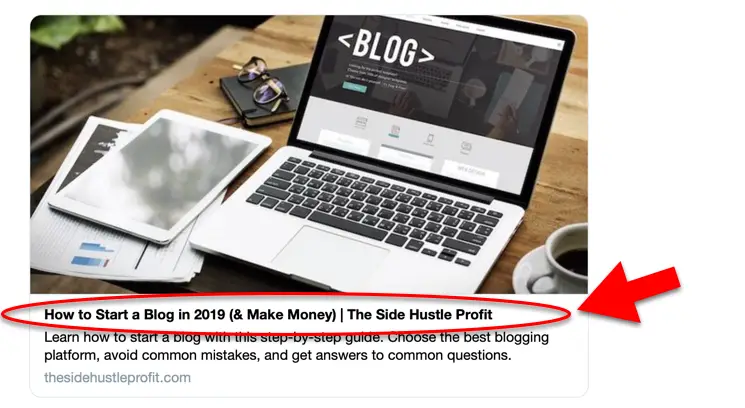
3. Be Specific, But Not Too Specific
Let’s say you wanted to start a food blog that includes recipes, dishes, desserts, and everything food related. Let’s also assume you make the world’s best cupcakes. When picking a name, you want it to be food related as opposed to naming your food blog after your cupcakes.
What’s a better hypothetical food blog name that ties to the target audience and the objectives you’ve set out? “Unlimited Kitchen Recipes” or “The Best Cupcake Blog”?
Although this example is exaggerated, it highlights the importance of picking a specific name (food related) but not too specific.
4. Avoid Using Numbers and Special Characters
Numbers are great for using in a blog post title but avoid using them in your blog title. Think about the end user for a quick second. Using the food blog example, what’s sounds and looks better? “Unlimited Kitchen Recipes” or “24 and more recipes”? Not only will the URL be long, it’s easier to remember something short and catchy.
If you must use a number (like the case for 23andme.com,) just be sure the name and title are aligned throughout your process of starting a blog.
5. Make Your Domain Name Brand-able
Your website visitors form an impression the moment they go on to your page or even read the URL. The domain name is an online representation and extension of your brand, so it’s extremely important to pick something that stands out from the competition, clearly highlights the value of what you’re offering, and easy to remember.
When it comes to picking a name that’s brand-able, it’s important to have that perfect name especially if you want to market offline (events, apparel, direct mail, etc.) Just think about the hassle you’d have to go through changing your name online and offline.
6. Using Thesaurus or Name Generator
We all have those days where our creativity is low, but luckily we have tools out there to help us. Note, some of these tools are actually helpful, and others are used as good examples to help your come up with thoughts and ideas.
- Domain Wheel: this tool helps show you available domains with a little help of their artificial intelligence algorithms. – Add screenshot
- Blog Name Generator: this tool will look at your Blog Goals, Target Market, Demographic Interests, Analyze Competitors Names, Brainstorm Ideas and get blog name inspiration
- Wordoid is a free tool that helps you choose a quality name without using more than 15 letters. Type in the word and the tool with come up with a number of options.
Once you have a list names you want to check for availability, enter it down below.
Where Should I Host My Blog?
There are a ton of options when it comes to hosting your website. From GoDaddy, HostGator, etc. the options are seemingly endless. However, our team has been using Bluehost from the very beginning, and even recommend it to our clients due to its simplicity and how quickly you can get a site up.
Benefits of Bluehost
Loading Speed: Bluehost boasts of exceptionally fast loading speed. Its average load time is a quick 424ms which is a key reason it takes minimal time to have your site up and running in the blink of an eye.
Ease of use: It can be a difficult task for beginners, not knowing where and how to begin setting up a website. Luckily for those users, everything is simplified. Its step by step process is easy to follow for users at any level.
Dashboard: First impressions matter – the first thing that draws users to Bluehost is their incredible and user-friendly dashboard. It has a central location to access all your tools, from managing your domain, setting up emails, and much more. If you’re worried about the site being too technical, don’t! Bluehost allows even non-techs to understand what is required to have their site working.
Website Security: Although Bluehost offers web hosting for less than a cup of coffee per month, don’t confuse the cheap price for a lack of features, especially security. By default, the tool offers a free SSL certificate and all plans include a domain privacy feature that allows you to keep your personal information private. On top of that, the tool SiteLock is also included that prevents malware attacks which are common across the web.
Customer Support: One of the most incredible features at Bluehost is their excellent customer support, available 24/7. It doesn’t really matter what time of day or night you want to set your website, or where you are on the globe, you always access all the help you need. You also easily access guides and video tutorials to make your process as simple as possible.
Bluehost Guarantee: Don’t like Bluehost or what you see? Simply return your plan. Feel free to try out the service for 30 days and if you feel like their service isn’t up to par, simply return your plan. Just be aware of the small caveats such as getting returns on the web hosting costs and not other products such as domains and add-ons.
How Do I Build A Website?
If you end up picking Bluehost as your web hosting platform, installing a WordPress site will take just a few minutes. Check out the video below to see how easy it is!
Customizing Your Website
Once you have WordPress installed on your site, you can access your dashboard by going to: http://www.yourdomain.com/wp-admin. The key is to add “/wp-admin” after your domain. Once here, you’ll see a login screen like the one below.
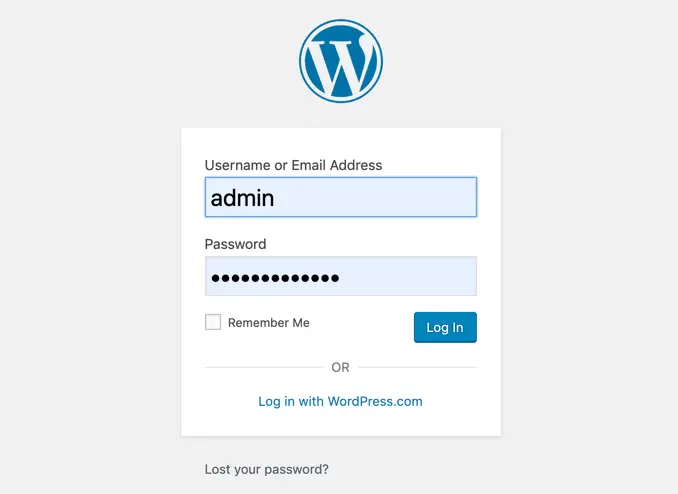
Picking a WordPress Theme
To pick a theme for your blog, you’re going to want to head over to ‘Appearance’ section in your Dashboard. The dashboard is customized for your own user experience, so it might not look the same for everyone.
Under the ‘Appearance’ tab, you’ll want to navigate to sub-section for themes. Themes are crucial to your website because they control the entire design of your site.
WordPress offers a number of free themes, and also a number of upgraded themes, but you’re not limited to what is available on the site. You can buy themes from other sites such as ThemeForest or TemplateMonster. Installation is easy and takes only a matter of a few minutes.
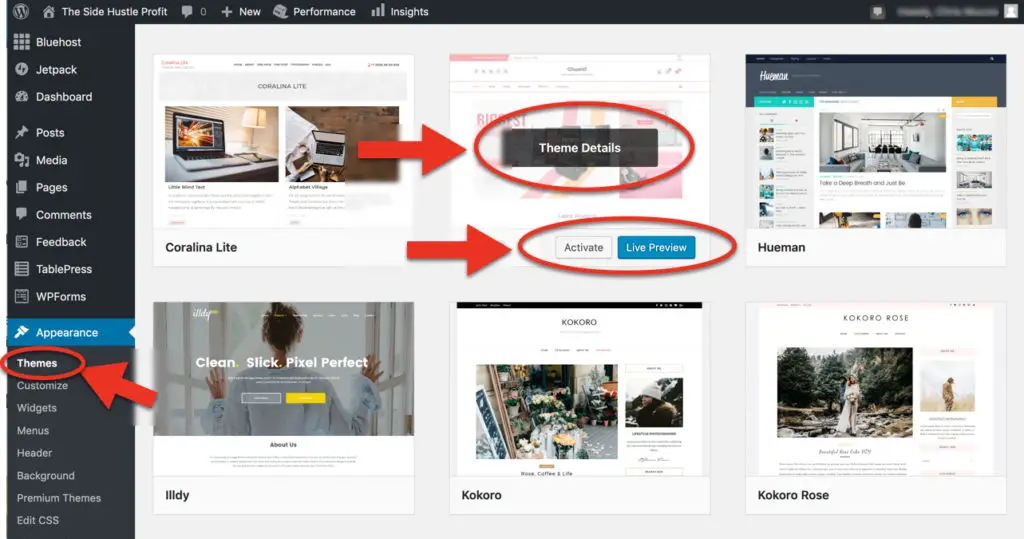
If you have a specific theme in mind for your blog, take the time out to pick something that fits your need. For example, if you’re looking to build newspaper themed website, take the time to look for themes that publish your latest blog posts to the top.
Maybe you want to mimic a theme of a site you frequently visit. Take Buzzfeed for an example, you can search “Buzzfeed WordPress themes” and see what you can find.
The best part of using a theme from WordPress’s library is that you can preview it to see how it would translate with your existing content. If you don’t like what you see in the live preview, you can go back and find another one. If you do like what you see, you can click activate and the theme would be installed in seconds.
How to publish a blog post
At this point, you have your website up and running! Now it’s time to fill your website with content. Publishing a blog post is extremely simple but don’t get this confused with publishing an optimized blog post, (we’ll discuss that next.)
To publish your first post, go to the left menu and click “Posts” and then “Add new.” You may see an existing default post in here, you can un-publish or move it to the trash.
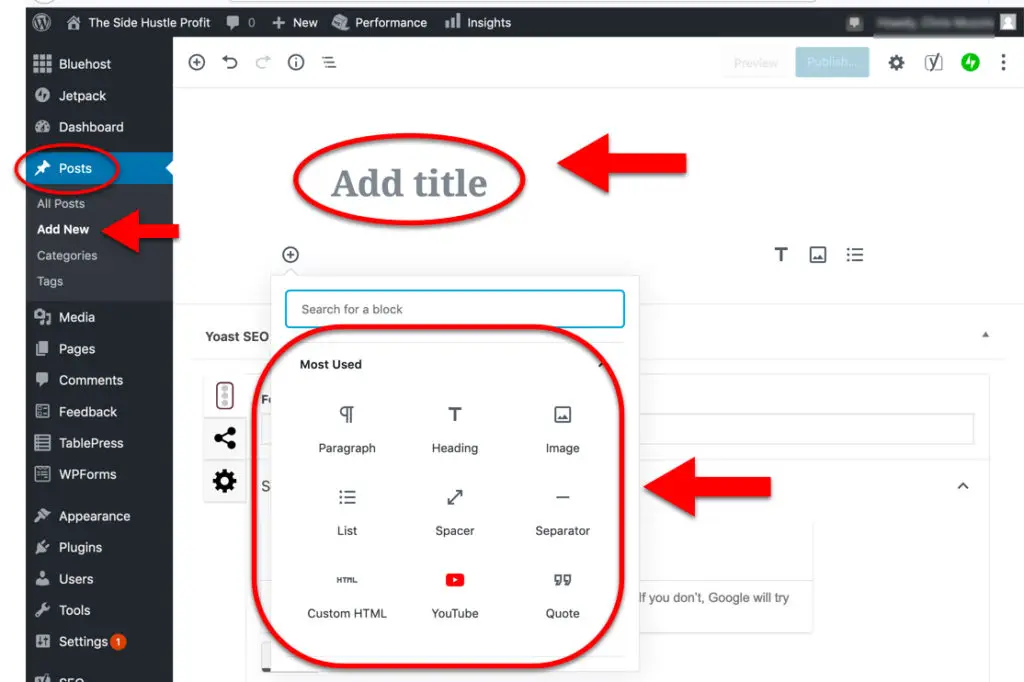
It’s easy to add text, headers, images, multimedia, and much more using WordPress. As soon as your blog post is ready, you can simply click publish.
So now that all the set-up and technicalities are out of the way, it’s time to get started blogging!
Bonus Reading: How to Create a Content Calendar in 3 Effective Steps
What to Blog About?
“What should I blog about?” A question all of us have asked at some point in our content creation career. Whether you are just starting out and don’t know which topic to start with, or have hit a writer’s block after your 30th post idea, know that you are not alone, and that there are actually numerous ways you can get over this.
Talk to Your Audience
This is perhaps the best ways to come up with ideas for blog topics, since you are directly asking those who are actively reading (or will be reading) your posts. So how do you get started?
One of the go-to methods most of us have today is social posting. If you have a few followers on your social channels simply post the question, a poll, or ask them to leave a few constructive comments to help you brainstorm, and come up with fresh ideas (or spins on ideas you might have already written about.)
If you have an email list you can also ask your subscribers for new ideas. But now you might be asking “what if I have neither?” Again have no fear, you can always post surveys on social media, and in forum sites where they can be seen by numerous eyes daily.
Brainstorming for blog topic ideas this way will not only help you write about topics you know will get read, but it also helps with search engine optimization (SEO). What do we mean by this?
Well, if your audience, followers, or subscribers are asking for the recommended topics, chances are that other people in the same niche are too; and if so many people are asking, it probably means that no one else is covering the topic.
What Questions is Your Market Asking?
Speaking of your niche, what are other people asking about? What are their broader pains, needs, or interests? What is it that they want, but almost nobody is covering? Scouring the net can help you find out what to blog about:
- Enter market-related forums
- FAQ sites
- Social platforms such as Facebook, Twitter, and even Instagram
You can also perform a light competitive analysis and see what other competing bloggers are writing and posting about. What comments are they getting, and most importantly are they answering and engaging their audience’s questions. This might be an ideal opportunity for you to jump in.
Once you’ve written the post, you can go back and provide concise answers to their questions, and if they want some more details you can provide a link taking them to your blog.
Bonus Reading:What is Social Listening?
Using Web-Based Research Tools to Find What to Blog About
If you need a more focused method, and you don’t have the time to manually search for questions, why not let technology do it for you?
There are free tools online that can provide you with multiple topic ideas. All you have to do is enter a keyword or topic, and the tools will automatically generate a plethora of new ideas based around the phrase you entered. Such tools include Soovle.com and AnswerThePublic.com.
Another great free method for brainstorming ideas based on a keyword or phrase is using search bar recommendations. Search engines such as Google have autocomplete features when you enter a keyword. Look through the various recommendations and see if anything sparks any ideas.
Bonus tip: You can also use the LSI keywords at the bottom of the search results.
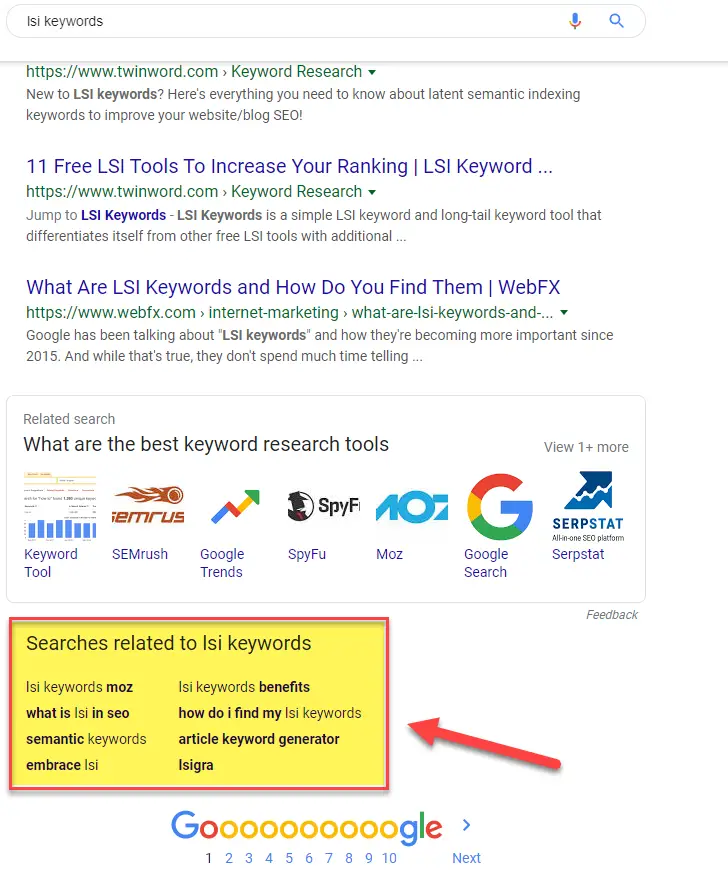
If you have a budget set aside, there are other great tools that cannot only help you with brainstorming, but they are perfect for a more in-depth market, and competitive analysis (that will come in handy later on.)
Tools such as Ahrefs and SEMrush are both excellent for providing alternative keywords and phrases, along with their competitive stats (monthly search volume, ranking difficutly, clicks etc.)
Bonus tip: If you like what these tools offer but cannot currently afford a subscription you can always opt for a free trial. Also there is a fairly new tool called Ubersuggest. It works the same ways as Ahrefs and SEMrush when it comes to finding winnable keywords and their variations for brainstorming.
If you’re interested in giving the tool a go, here is a video from WPCrafter showing you how to use Ubersuggest.
Finally, Buzzsumo is another excellent tool which can help you see what is being posted, asked, and shared, all from a simple and easy to use dashboard. This basically automates the manual process of scouring the net we mentioned earlier.
Bonus Reading: Struggling With Keyword Discovery? Try These Tools!
Now that you know how to get your creative juices flowing, its time to move on to the next big thing…getting traffic to what you created.
How to Optimize Your Posts and Start Driving Traffic to Your Blog
“Build it and they will come” this is a phrase that does not apply in content marketing. In order to start getting traffic to your blog you will first need to get your blog noticed by search engines.
So how do you optimize your posts and start to drive traffic to your blog? Let’s dig in
Choose the Right Keywords
Search always starts by typing in a relevant keyword or phrase. By now you should know your audience well enough to understand what kind of content and topics they will want to read about. Each blog post though needs to be built around a competitive or “winnable” keyword. What is a winnable keyword?
- One that is relevant to your audience’s interests
- One that gets over 100 monthly searches
- One that has a difficulty of <50
Here is an example using Ahrefs.com:
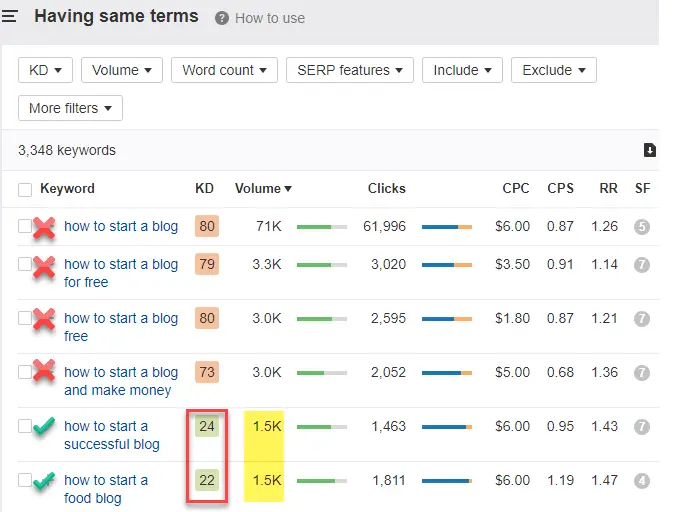
While the first bullet is fairly simple to understand, you will need a tool to determine the other two.
A great free tool that you can use is Ubersuggest we mentioned earlier. It provides you with all the necessary information you will need to determine if a keyword is worth using to base your blog post around, and if it will ultimately help get your blog noticed.
Keyword Usage and Placement
Once you’ve found the winnable keyword(s) you will be focusing on, it’s time to start implementing On-Page SEO.
On-Page SEO essentially refers to the strategic placement of your selected keywords throughout your page. This will make it easier for search engines to crawl through, and rank your content.
Here is how to optimize your blog post for optimal SEO results:
1. Add your keyword in your title
While this might seem like a no-brainer, you would be surprised with how often it’s overlooked.
Bonus tip: The closer you place your keyword to the beginning of the title, the better
2. Add your keyword in your URL
Whenever you start a new blog post, you have the ability to customize its URL. URLs also play a major role when it comes to search engines crawling and understanding what your post is about, so make sure your keyword is always included. An easy way to be sure that your keyword is included in your URL is to add your title: “www.example.com/blog/your-post-title”
3. Add your keyword in your metadescription
Metadescriptions are another overlooked element when creating a new blog post. Not only are they important for search engine crawlers, they also provide your audience with crucial information about the post. Be sure to always create brief, but detailed metadescriptions, and try to add your keyword as close to the beginning as possible.
4. Adding your Keyword in your Main Body – Keyword Density
While it is important to use your keyword throughout your content’s body, you will need to avoid falling in the trap of keyword stuffing. Be sure your keywords fits organically in the post, do not force it in every sentence as this will significantly reduce the quality of your piece.
Bonus tip: Google will actually penalize you for keyword stuffing, so aim for a density of around 1-3% to be safe.
5. Add your keyword in your H2 tags
While not necessary to be included in every single heading in your post, including your keyword in some of your H2s can be very beneficial, and further aids search engines when crawling your post.
6. Use Your Keyword in Image Alt Tags
Alt-text is the “label” describing what your image is about. You might have seen this when hovering over an image online with your mouse; after a few seconds a little bar of text will pop-up. Search engine crawlers cannot see images or videos, so an image with no alt-text is basically invisible, or nonexistent. Always make sure you add alt-text to the images you add to your post.

Bonus tip: If you can organically add your keyword to your image’s alt-text, you might even increase your blog’s SEO performance.
7. Use Internal Linking
Internal linking plays a major part in optimizing your blog post. This shows search engines that you have multiple pieces of content that supplement each other in offering more value to your visitors. This also helps your audience stay longer on your blog by clicking around, and exploring more of your content. These are both big wins in the eyes of search engines, and can boost your potential of ranking higher.
8. Choose the Right Anchor Text for Links
Anchor text is also a very important aspect of both internal and external linking. This is the text that will appear to be hyperlinked on your post, so it’s important that your anchor text describes what you are linking to. This could either be done by including a keyword from your linked content, piece of its title, or simply a short (few word) description.
The blog optimization options we discussed above are a great starting point in getting your blog noticed by search engines and audiences, but it doesn’t stop here. If you truly want to get traffic to your blog you will need to follow some fundamental content distribution guidelines.
Content Distribution: How and Where Should You Be Promoting Your Blog
We just spent a large portion going over how to optimize your blog for it to get noticed by search engines. This is where it all pays off. A properly optimized post will rank higher for the keywords it was optimized for. Having said that, while extremely important, SEO is only a piece in the larger “content distribution” puzzle.
So what else is there?
Off-Site SEO
While this may be surprising to some, you can build your blog’s notoriety with Google through other websites. Having reputable websites link to your content will boost your Google ranking, making it easier for your audience to find you.
So, reach out to other, more established bloggers and see if they’ll let you publish a guest post on their website that links back to yours. This simple practice can carry great results when performed consistently over time.
On-Page SEO, has to do with optimizing things that are physically sitting on your page, to help boost rankings. This is what we worked on before. On the other hand Off-Page SEO is a tactic that takes place outside the realm of your site. Off-Page or Off-Site SEO refers to backlinks; links that are physically sitting on pages from other sites, that link back to your blog post, or page.
There are 2 major benefits in getting backlinks. The first is that Google (and search engines in general) really favor a page with many sites linking back to it. They consider this to be a sign of very high quality content, and will therefore give it a boost when deciding where to rank it. The second benefit is that backlinks generate referral traffic. If other websites are linking to your content, a large portion of their readers might click on the link and come to your post to check it out. This means greater exposure for you.
There is a catch however. Not all links are equal. Links from high domain authority websites will far outweight links from sketchy, low domain pages. While Google heavily favors the former, it can actually penalize you if your site is getting many low domain authority backlinks, dropping your ranking.
The biggest takeaway here is, it’s not the quantity of backlinks that really matters, it’s the quality.
So how does one get backlinks? The simple answer is, with great quality content. The higher the value of your blog posts, the greater the chance of another site linking back to your content either as reference, or as a supplementary piece to what they are talking about. This process is not immediate though, it will take some time.
Guest Posting
If you would like to speed up the process of gaining some backlinks you can always try guest posting. By publishing your piece of content on someone else’s site you are not only increasing your potential reach, but you can also generate some organic backlinks by adding some of your other blog posts as reference.
A note of caution here. If your guest posts seem like they only exist to provide you with a backlink (aka self promotion) they won’t be accepted. Always aim to provide quality content even if it’s not going to be sitting on your site. A well written post will always be favored by other sites, since they want to provide their own audience with value as well.
Utilize Social Media
Social media is perhaps one of the most powerful tools you can use for content promotion and distribution. It is essentially a portal to hundreds of thousands of your audience members. At the same time however, it is also one of the most saturated places to post content. Due to the literal thousands of photos, tweets, videos, links, being uploaded every minute, chances are that simply uploading a new piece of content to your profile won’t have any effect. It will simply be drowned in a sea of content.
The trick here is similar to optimizing your blog. Create an engaging headline with a keyword you know people will look at. Add a compelling image that will cause audience scrolling to pause and look again. Use tags and hashtags to your advantage by putting the keyword and other interesting (but relevant) phrases that will catch the eye of visitors. You want your posts to not only be valuable, you want them to be engaging, and most importantly, you want them to be “sharable.” And what tends to go viral? Things people frantically share with each other.
Having said that, don’t create “clickbait” post with the only intention being going viral. Take your time with your posts, and try to build your following. If you see some posts gaining traction, thank those who shared, interact with those who commented, and liked. You ultimately want your content to have a quality reach, not to go viral with little to no results. In other words, you want your blog content and what you say to be shared, not a simple social post.
Bonus: Each social platform performs best in certain niches. Choosing the right one comes down to where your audience is. Do some research, scope out where of your audience spends most of their time, see what kind of posts work best with them, understand which are the best times to post, and then start posting.
Content Syndication
Content syndication is not a new thing. In fact it’s been around since the dawn of the newspaper era. Today, things work a bit differently. Content syndication is now the practice of having a third-party website feature, or republish your content. Great examples of such websites include Growthhackers.com and Medium.com. How do they work? Simple.
Create a free account, and start publishing. That’s it. The content you publish here does not need to be paraphrased as it won’t be considered duplicate by search engines.
A trick many use here is writing up a summary of what their post is about, and then providing a link back to their website, where readers can read the full original post. By doing this you are not only getting additional exposure, but you are also getting a backlink (as we mentioned earlier.)
Sites that syndicate content don’t exist just to please bloggers who want more eyeballs. It is a mutually beneficial relationship: They get free content posted on their site (which puts them on the map, acting like a smorgasbord of content) while you get the exposure you’ve been seeking. Note that simply posting something on a syndication site does not mean it will immediately get thousands of views. You will need to offer something that is really compelling, the more engagement your posts gets, the larger the following it will start to rack up.
Utilize Forums
Forums are another medium that often goes unutilized by many bloggers. Everyday hundreds or even thousands of people enter forums to discuss, ask questions, catch up on trending topics, and so on. Why not leverage this? If you find a person asking a question that one of your posts currently answers jump in.
Interact with such commenters, provide a concise answer that will answer their question to a degree, and then for additional information provide them with a link to your full blog. This will not equate to only one view, it can equate to multiple hundreds. Usually, “best answers” will be upvoted in such forums bringing them close to the top. The more people that enter with a similar question and see your answer, the greater the exposure for your post (and ultimately your blog.)
Lead Gen: How to Generate Leads for Your Blog
So you’ve spent a lot of time and effort getting people to notice your blog. Let’s say that your at a point where you’re getting tens, hundreds, or even thousands of views every week. Now what? How do you leverage this traffic and start to make money? The answer is by generating “leads.”
Before we continue, for those that are unaware of the term, a “lead” is what we call a potential customer. For a lead to be created you will need a way to get some of that individual’s contact information such as their name, emails address, and phone number. This will ultimately allow you to leverage your traffic, and pave the way for monetizing your blog.
So how do you get started?
Top Ways to Generate Leads from Your Blog
Opt-In Forms
Without a doubt, opt-in forms are the best way to capture leads, they are simple to follow, and require minimal effort from your visitors. There is one very important thing to keep in mind though. Only ask for information you need, and make it as unintrusive as possible. If you don’t need personal information such as their home address, date of birth, phone number, etc. don’t ask for it. Oftentimes, just by adding one unnecessary field (or making the process complicated) will cause tons of prospective customers to flee. I’m sure you’ve left an opt-in form or shopping cart because someone else asked for a little too much, right?
How Can You Make Your Opt-In Form Visible to Visitors?
There are three ways that you can promote your opt-in form.
- Within your blog copy. Strategically place it on your page (be it within the blog, or on the side banner,) and be sure it stands out, to catch the reader’s eye.
- Create a pop-up while your readers are scrolling. While this can be annoying at times, it’s a sure way you will get your form seen. This is where the offer comes into play. The more appealing and valuable it is, the better the chance of someone clicking. We’ll expand more on this in a bit.
- Similar to the above, make the pop-up appear when your readers are about to leave the page.
Note: All three options are viable, but it’s best to just pick one. Using more might annoy your readers and even make you look desperate.
Creating a High Impact Opt-In Form
- Be Specific – Use phrases like “join now” and “subscribe today!” Don’t hedge your words.
- Keep it Simple – Like we said before, only ask for information you need. Don’t fill your opt-in form with extra fields (i.e., a phone number or physical address) if not 100% necessary. Most often you will find that just a name and email address will suffice.
- Make it Noticeable – Have it stand out from the rest of the imagery on your blog. Use contrasting colors, boarders, backgrounds, etc. to visitor’s attention.
- Keep it On the Same Page – Try not to direct a reader to another page (unless necessary.) This might be considered disruptive, and lead to lower capture rates.
Calls-to-Action (CTAs)
CTAs can be placed anywhere on your blog in the form of images, text, or hyperlinks, and can even be added to your opt-in forms. A high-quality CTA should be enough to cause your readers to act. Examples of CTAs include: “sign up to our newsletter”, “download your free ebook”, or “buy now.”
Creating High Quality CTAs
- Use Psychology – Capitalize on your readers’ fear of missing out (FOMO.) Use limited-time offers, countdown timers, and other tactics that insinuate exclusivity to the offer.
- Customize Each CTA – Chances are you won’t just have one CTA on your blog. Make sure each one is unique, stands out from the rest, and have a clear message for your visitors. For example, if your goal is lead generation, your CTA should be focus on making readers to subscribe to a mailing list or sign up for a free offer (i.e., digital e-book).
- Understand What Your Audience Wants – If you want your audience to give you their contact information, you will need to make it worth their effort and info. What is it that they want in return? Exclusive content? Additional Info? How to guides? Infographics? Ebooks? Whichever the case you will need to tailor the CTA to fit the user’s needs, and make what they will be getting in return apparent from the get-go.
Create a Valuable Offer
Even though it might seem minor in your eyes, providing an email for a free offer is still a transaction. You will therefore need to offer up something that is of high enough value, deemed worthy of your audience’s personal information.
Some good ideas, people often find valuable:
- Exclusive information and updates via an email newsletter
- Exclusive discounts and coupons
- Exclusive access to high level content not available on your site
- A free e-book/guide
- A free trial offer of a product or service
Whichever the case, always be sure to offer high quality offers your audience will want to exchange their email for.
How to Make Money from Home: Monetizing Your Blog
So now that you’ve learned how to set everything up, what to blog about, how to get traffic to your blog, how to optimize it for search engines, and how to generate leads, its time for the big question. It’s all been leading up to this. How do you make money from home while blogging?
Reap the Benefits of Affiliate Links
One of the simplest ways for generating income while blogging is through affiliate links.
What is Affiliate Marketing
In case you didn’t know, affiliate marketing is the process of adding a special link to your blog that will refer traffic to an online retailer. If a referred person makes a purchase, you get a percentage (commission) from that transaction.
So how do you get started?
While building, hosting, brainstorming for, and optimizing your blog; chances are that you used various tools (we even made some recommendations throughout the post as well). So if you are already using some tools that you find useful, why not make some money off of them? You can either mention them in your blog posts, recommend them to your readers (like we did in this blog,) or you can straight up write a post on how to use these tools once you have a bit more experience with them.
Speaking of things you use and would recommend to someone else, why not try to sign up for programs offered by some of your favorite brands or products. If you are a fan of videogames, and find yourself playing a bit in your free time, why not make some money on the side through gaming affiliates. The same can be said for other software products such as VPNs, video editors, sound editors, office equipment, etc. etc., the sky is the limit here.
Affiliate links are a great source of passive income. They’re the ultimate “set it and forget it” type of income stream, but there is one important thing you need to keep in mind. Choose your affiliate links wisely. We recommended tools and products you use on a daily basis before for a reason. You know them well. Always be aware of the quality of what you are promoting, don’t sign up for any affiliate program under the sun. Some brands or products might not have the best reputation, or might be faulty. Recommending such things might “hurt” you more than they will benefit you. And if you decide to promote a product you currently are not using, always do your research before doing so. If your audience benefits from these links, so will you.
Create Something and Sell It
Blogging is like any other business, the best way to make money is to actually sell something you created. Although this can be a physical product, you don’t need to complicate things early on. Create virtual products such as:
- Infographics
- eBooks
- Exclusive videos
- Exclusive slides
- Series of recordings
- An actual class/course
- Digital workbook
- Digital guides
Most of these can be created fairly quickly with not much additional effort needed. How’s that you ask? Think of it as 1+1=3. You already spent a large amount of time creating high value blog posts, instead of creating things from scratch why not repurpose your existing content? Pull some relevant posts together, preferably those that supplement each other well and create an ebook or guide? Have some good posts you are proud of? Record yourself reading them out loud, or talking about the topic, and adding your spin for a podcast, audio clips, or even videos. Good with designing things? Break down the essential pieces of your blog posts and convert them into infographics or slides.
If you need some help with creating, editing, or designing, also remember that you are not alone. There are plenty of freelancers and professionals in sites such as Fiverr and Upwork that can help you out for a relatively low cost.
Speaking of freelancers…
Hone Your Skills By Freelancing
Blogging, like anything else, is a skill. And the more you practice, the better you’ll be at delivering a message that is not only valuable, but also interesting for your readers. Offer your blogging services to other sites on a freelance basis. If you are at a level where you are efficient enough in writing your own content and have some time left over, why not take up helping others create content as well?
Not only can this work as great practice, but it will also open you up to new ideas or new niches you might want to explore later on. Even better however, you will be getting paid directly for writing content, rather than stressing to monetize it.
Final Takeaway
And that’s pretty much it…I know it’s a lot to take in, especially in one sitting. Like I said in the intro of this post, don’t try to eat the whole elephant in one bite. Save this article in your favorites and revisit it whenever you need. Tackle each step at a time, and most importantly have fun with it. This is your passion project, no need for it to get overwhelming, stressful, and boring. And remember…
When working out how to monetize a blog, remember that one thing always comes first “value.” Providing valuable, and engaging content for your readers is key when creating content, and more importantly when trying to monetize it.
If you have any questions and comments please feel free to add them in the comments below. We would be more than happy to answer anything and start a conversation with you. Also be on the lookout as we will be periodically be adding a few updates to this post.
Recommended Reading:




